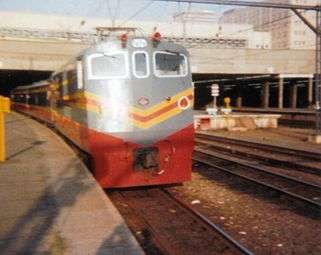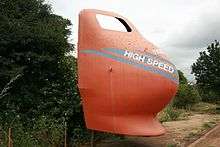MetroBlitz
MetroBlitz was an experimental high speed commuter train service between Pretoria station and Johannesburg Park Station via Germiston, operated by the South African Transport Services (SATS). It started service on 16 January 1984.[1]
| MetroBlitz | |
|---|---|
 The MetroBlitz at Johannesburg station in September 1984 |
History
High Speed Test Locomotive

During the 1970s, Dr. Herbert Scheffel of the SAR experimented with self-steering bogies which not only reduced flange wear on goods wagons, but also opened up the possibility of running at high speed in passenger service on Cape gauge.[2]
In 1978, one of the Series 4 units, no. E1525, was modified for experiments in high speed traction by re-gearing the traction motors, installing SAR-designed Scheffel bogies and fitting a streamlined nose cone on the no. 1 end. In this configuration, no. E1525 reached a speed of 245 kilometres per hour (152 miles per hour) hauling a specially-adapted suburban coach on a stretch of track between Westonaria and Midway on 31 October 1978, a still unbeaten narrow gauge world speed record on 3 feet 6 inches (1,067 millimetres) Cape gauge.[3][4][5][6]


During November 1980, the same locomotive was used to test the British Rail-Brecknell Willis single-arm high speed pantograph, then still under development, as part of the SAR's research towards introducing a new high speed MetroBlitz service between Pretoria and Johannesburg. A number of European pantographs were being evaluated for use on the Class 6E1, with the trains running at 90 miles per hour (145 kilometres per hour) under catenary which usually saw nothing above 50 miles per hour (80 kilometres per hour). Testing took place over a 10-kilometre long (6.2-mile) stretch of straight track between Rosslyn and De Wildt on the line between Pretoria and Brits. During the trials, speeds of up to 125 miles per hour (201 kilometres per hour) were achieved with the pantograph.[5]
In the 2000s, similar single-arm type pantographs were adopted by Spoornet. These pantographs gradually replaced the older box-frame type pantographs on all electric locomotive types as and when replacement became necessary. Along with Class Experimental AC no. E1600, no. E1525 is still dedicated to testing projects since its different gear ratio and traction effort curves make it unsuitable for use in multi-unit working with other Class 6E1 locomotives in the fleet.[7][8]
| HIGH SPEED LOCOMOTIVE AND TEST COACH | CURRANT LOCATION | DISPOSAL | |
|---|---|---|---|
| 1525 | KOEDOESPOORT | MUSEUM | TRANSNET HERITAGE FOUNDATION |
| 11796 |
MetroBlitz Locomotives (12E)
Manufacturer The 3 kV DC Class 12E electric passenger locomotive was designed and built for the South African Railways (SAR) by Union Carriage & Wagon (UCW) in Nigel, Transvaal, with electrical equipment supplied by General Electric Company (GEC). It was a modified single-cab version of the Class 6E1, Series 10 locomotive and was specially designed and built for use with the MetroBlitz, a high speed passenger commuter train which ran daily between Pretoria and Johannesburg with effect from 16 January 1984.[9]
Five locomotives were delivered by UCW in 1983, numbered in the range from 12-001 to 12-005. Like the Class 6E1, Series 6 to 10, the Class 12E units were equipped with AEI-283AY traction motors. UCW did not allocate builder's numbers to the locomotives it built for the SAR, but used the SAR unit numbers for their record keeping.[10]
Characteristics Based on the dual cab Class 6E1 locomotive, the Class 12E was a single-cab locomotive with a conductor's cabin at the rear end. They were used with specially designed suburban passenger coaches which rode on air-sprung disk-braked high speed Scheffel bogies. The MetroBlitz operated with two locomotives per train, one unit at each end, which made dual cabs unnecessary.[10][3]
Like the Class 6E1, the Class 12E was built with sophisticated traction linkages on their bogies. Together with the locomotive's electronic wheel-slip detection system these traction struts, mounted between the linkages on the bogies and the locomotive body and colloquially referred to as grasshopper legs, ensured the maximum transfer of power to the rails without causing wheel-slip by reducing the adhesion of the leading bogie and increasing that of the trailing bogie by as much as 15% upon starting. This feature was controlled by electronic wheel-slip detection devices and an electric weight transfer relay which reduced the anchor current to the leading bogie by as much as 50A in notches 2 to 16.[3]
The Class 12E had the same power output as a Class 6E1, but with a higher gear ratio of 23:66 compared to the 18:67 of the Class 6E1. This enabled it to run at a safe maximum speed of 150 kilometres per hour (93 miles per hour). Since it was designed for suburban service, sanding gear was deemed unnecessary and was not installed on the Class 12E, as evident from the absence of the sandbox lids seen along the bottom body sides of most Class 6E1 locomotives. This turned out to be a disadvantage when they were eventually allocated to mainline service to haul the Blue Train.[10][3]
| Locomotive | Status | Location | Disposal |
|---|---|---|---|
| 12-001 | SOLD TFR AUCTION | * | Scrapped |
| 12-002 | SOLD TFR AUCTION | * | Scrapped |
| 12-003 | SOLD TFR AUCTION | * | Scrapped |
| 12-004 | SOLD TFR AUCTION | * | Scrapped |
| 12-005 | Preserved | CURRENTLY STORED KOEDOESPOORT | TRANSNET HERITAGE FOUNDATION |
Demise
Poor cost recovery and disruption to other slower train services are cited as the reasons for the demise of the MetroBlitz.<ref>"Gautrain Rapid Rail Link - Feasibility of the Project". Bohlweki Environmental. 24 March 2003. Retrieved 6 June 2010.</re
After the MetroBlitz service came to an end in 1985, the five Class 12E locomotives were repainted blue with yellow whiskers and replaced Class 6E1 numbers E1341 to E1345 as Blue Train locomotives between Pretoria and Kimberley. Probably at the same time, their original unpierced cowcatchers were replaced with ones with a pattern of holes, similar to those used on the Class 5E and Class 6E families but slanted back towards the front bogies.[10][6][4]
They worked the Blue Train between Pretoria and Kimberley until about 2005, when that function was taken over by the dual voltage Classes 14E and 14E1. These were able to work the Blue Train over the full distance between Johannesburg and Cape Town across the 25 kV section between Kimberley and De Aar as well as on other electrified routes.
METROBLITZ ROLLING STOCK
| NUMBER | BUILD FROM OTHER COACHES | LOCATION | DISPOSAL | ||
|---|---|---|---|---|---|
| 50000 | |||||
| 50001 | X | Scrapped | |||
| 50002 | |||||
| 50003 | X | Scrapped | |||
| 50004 | |||||
| 50005 | X | Scrapped | |||
| 50006 | X | Scrapped | |||
| 50007 | NR 40066 | X | Scrapped | ||
| 50008 | |||||
| 50009 | |||||
| 50010 | |||||
| 50011 | |||||
| 50012 | X | Scrapped | |||
| 50013 | X | Scrapped | |||
| 50014 | |||||
| 50015 | |||||
| 50016 | NR 40065 | X | Scrapped |
See also
References
- JNC Boomzaaier (2008). Tracks Across the Veld. JNC Boomzaaier. p. 12. ISBN 978-0-620-41711-2.
- Soul of A Railway, System 7, Western Transvaal, based in Johannesburg, Part 17: Northwards to just short of the home signal at Pretoria by Les Pivnic. Introduction. (Accessed on 27 April 2017)
- Paxton, Leith; Bourne, David (1985). Locomotives of the South African Railways (1st ed.). Cape Town: Struik. pp. 128–129, 133–134. ISBN 0869772112.
- Middleton, John N. (2002). Railways of Southern Africa Locomotive Guide - 2002 (as amended by Combined Amendment List 4, January 2009) (2nd, Dec 2002 ed.). Herts, England: Beyer-Garratt Publications. pp. 56–57.
- Pantograph Testing in South Africa in 1980 (Accessed on 6 June 2017)
- Soul of A Railway, System 7, Western Transvaal, based in Johannesburg, Part 27: Braamfontein West to Klerksdorp (home signal) by Les Pivnic, Part 2. Caption 33. (Accessed on 7 May 2017)
- Facebook Group Suid-Afrikaaanse Spoorweë / SA Railways / Ulolwe - Comment by Philmar du Plessis: 24 May 2015 at 19:29 (Accessed 17 August 2015)
- "High Speed on SA Transport Services & World Record on test".
- "UCW - Electric locomotives" (PDF). The UCW Partnership. Archived from the original (PDF) on 12 October 2007. Retrieved 30 September 2010.